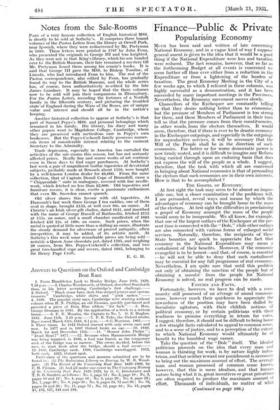Notes from the Sale-Rooms
PART of a very famous collection of English historical MSS. is shortly to be sold at Sotheby's. It comprises three bound volumes of the Poston Letters from the library at Orwell Park, near Ipswich, where they were rediscovered by Mr. Pretyman in.1889. These letters were printed in 1787 by John Fenn, who presented the originals to George III and was knighted. As they were not in that King's library, which his son handed over to the British Museum, their fate remained a mystery till Mr. Pretyman found them among his cousin's books. It is said that George III gave the MSS. to Bishop Tomline, of Lincoln, who had introduced Fenn to him. The rest of the Paston correspondence, nlso edited by Fenn, has gradually found its way to the British' Muieum, and the whole series has, of course, been authoritatively re-edited by the late James Gairdner. It may be hoped that the three volumes now to be sold will join their companions in Bloomsbury. For the Poston Letters, recording the fortunes of a Norfollc family in the fifteenth century, and picturing the troubled state of England during the Wars of the Roses, are of unique value and interest and should all be in the nation's keeping.
Another historical collection to appear at Sotheby's is that part of Samuel .Pepys's MSS. and personal belongings which remained in his family. His library, his diary and many other papers went to Magdalene College, • Cambridge, where they are preserved with meticulous care in Pepys's own bookcases. But the Pepys-Cockerell family possesses numer- olds items of considerable interest relating to the eminent Secretary to the Admiralty.
Trade depression, especially in America has curtailed the activities of the sale-rooms this -season, but has not seriously affected prices. Really fine and scarce works of art continue even in these days to find eager purchasers. At Sotheby's last week a pair of magnificent Gothic tapestries of devotional subjects, probably made at Brussels about 1510, were bought by a well-known London dealer for £6,000. From the same collection, that of Captain Denzil Cope of Bramshill, came a " Chippendale " suite in mahogany, covered with fine needle- work, which fetched no less than £2;800.' Old tapestries and furniture covers, it is clear, excite a passionate enthusiasm that even Mr. Snowden cannot quench.
Old silver shares this favour with old tapestries. At Hurcomb's last week three George I tea caddies, one of them oval in shape, brought £153, at well over 80s. an ounce. At Christie's an Irish silver-gilt chalice, dated 1641, and inscribed with the name of George Russell of Rathmolin, fetched £115 at 155s. an ounce, and a small chamber candlestick of 1683 fetched £33 12s. at 160s. an ounce. Such prices, when the metal is quoted at little more than a shilling an ounce, illustrate the steady demand for silverware of proved antiquity, often irrespeative, it may be added, of its artistic merit. At Sotheby's this week some remarkable pieces are being sold— notably a Queen Anne chocolate pot, dated 1705, and weighing 28 ounces, from Mrs. Pepys-Cockerell's collection, and two great two-handled cups and covers, dated 1685, belonging to Sir Henry Page Croft. E. G. H.


















































 Previous page
Previous page